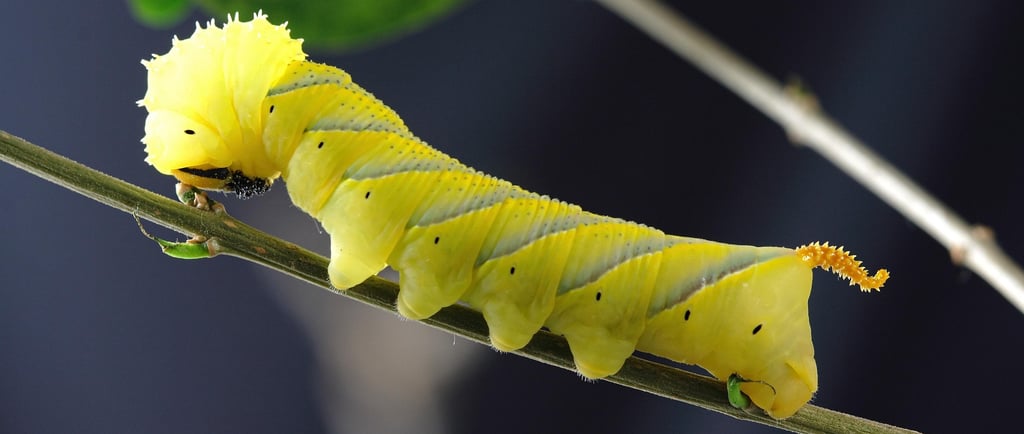The Secret Apprentices of the Garden 🐛🌿 Meet the Caterpillars
🌿 A follow-up story that connects The Plant and Zoology chapters in the Biology Album. 🦋✨ Inviting children to meet the often-overlooked apprentices of the garden—the caterpillars. Trough this story they discover how these little leaf munchers play a crucial role in the garden’s ecosystem: feeding birds, supporting the life cycle of butterflies and moths, and helping maintain natural balance. The story branches naturally from previous work on pollinators, food chains, and plant life cycles, inviting further discoveries: 💭 “Which caterpillars visit my garden? Which flowers feed the adults, and which plants care for the young?”
BIOLOGY STORIES
7/22/20253 min read


In every garden, there are quiet helpers. Some buzz 🐝, some crawl 🐞, and some flutter on the breeze 🦋. And then… there are the hungry ones. Known in many gardens as the “clean-up crew” —by munching fast-growing plants, they make room for other species to grow. 🌱 Look at this little creature—soft, wriggly, always chewing something. The very hungry caterpillar (👏 cat 👏 er 👏 pil 👏 lar)—the apprentice of the garden. 🌱
At first glance, it seems like trouble—nibbling on leaves, leaving little holes. But wait—before we rush to chase it away, let’s look closer.
Caterpillars are not just eaters—they are learners, growing through one of the most magical transformations in nature. Inside these tiny, stripy, or camouflaged bodies, a secret is waiting: the next generation of butterflies and moths. 🦋✨Each plays a role: feeding other creatures, pollinating night flowers, or simply keeping the balance in nature.
The garden needs these apprentices. While caterpillars eat leaves, they feed the birds 🐦, frogs 🐸, and even beetles 🐞. They help keep the garden food chain strong. Without them, birds would go hungry, and many plants would be left without their pollinator partners later on.
🌿 Just look at how many styles nature has designed for caterpillars! Some are dressed in soft, fuzzy coats—like they’re wearing tiny winter jackets. Image 1, Image 2, Image 3, Image 4 ❄️ Others look like cactus branches 🌵, covered in prickles to warn predators. Image 5 , Image 6 , Image 7 . Image 8, Image 9. Some are sleek and smooth, shiny like tiny green jewels 💎 Image 8, Image 9 , Image 10, Image 11. while others pretend to be sticks or leaves, blending perfectly with the plants around them. And then there are the giants among caterpillars! 💚 Like the Cecropia Moth Caterpillar , North America’s largest native moth. This bright green caterpillar is covered in spiky tubercles—those little bumpy ‘spikes’—in bright shades of blue and orange, like nature’s jewelry. ✨ As it munches on leaves, it quietly prepares for its incredible transformation into a moth with huge, velvety wings decorated in earthy reds and browns. 🍃 Every caterpillar is a masterpiece of survival.
And inside their wiggly little bodies? Incredible things happen. Caterpillars have more than 4,000 muscles 💪 (we humans have just over 600!), allowing them to curl, climb, and move in amazing ways. They don’t breathe through mouths like we do—along their sides are tiny breathing holes called spiracles 🌀. And if you watch very closely, you might spot their unusual heart beating ❤️—life pulsing through every segment. Their heart is not like ours, and doesn’t beat all the time like ours—it pulses in waves, carrying a clear or pale greenish fluid through their soft bodies.
When they are ready, caterpillars spin cocoons or hang silently in a chrysalis, becoming nature’s mystery box. Inside, the body of the caterpillar melts, reforms, and awakens as a winged friend—ready to dance from flower to flower, helping plants make seeds. 🌸➡️🦋
Not every caterpillar is a pest—some are secret helpers! For example, swallowtail caterpillars munch on wild carrot and fennel 🐛🥕, controlling fast-growing plants and letting the rest of the garden thrive. Gardeners can plant “snack plants” like nasturtiums or leave a little wild patch so caterpillars can munch happily while main crops stay safe.
💭 I wonder… What kind of caterpillars live in your garden? Do they turn into butterflies or moths? What do they eat—and who eats them? How do animals know which caterpillars are safe to eat?
💡 Possible Follow-up Explorations
🖼️ Make a “Caterpillar Gallery”—printable cards with common garden caterpillars and their adult butterflies or moths.
🌿 Observation chart: “Who is eating what?”—note which plants attract the most caterpillars.
🦋 Lifecycle work: include simple lifecycle sequencing cards (egg, caterpillar, pupa, adult). Children can make a chart and add little paragraph about each stage.
🎨 Art project: “The Secret Heroes of the Garden”—draw posters of helpful bugs like caterpillars, bees, and ladybugs.
🌍 Map exploration: Where do famous migrations happen (e.g., Monarch butterfly)? Introduce a small geography link.
With Montessori joy,
Vanina 😊

